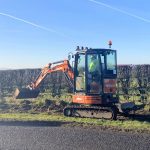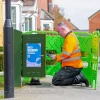Openreach UK Finish FTTP Build to 10000 Premises in Twickenham
Broadband speeds of up to 1Gbps should now be possible for around 10,000 homes and businesses across Twickenham (London) after Openreach (BT) completed their rollout of a new ultrafast Fibre-to-the-Premises (FTTP) network in the area, which forms part of their wider “Fibre First” strategy.
The effort is part of their work to reach 4 million premises with FTTP across the United Kingdom by March 2021, which could be extended to 15 million by around 2025 and they may even go beyond that if the conditions are right (e.g. easier wayleave agreements, extension to the business rates holiday etc.). So far around 1.3 million premises have already been reached and their rollout is continuing to ramp-up.
The new CEO of BT Group, Philip Jansen, recently predicted that it would cost “roughly” £400m to £600m (capital expenditure) a year to meet their FTTP ambition of 15 million UK premises (here).
Advertisement
Kim Mears, OR’s MD for Strategic Infrastructure Development, said:
“We’re delighted that the first residents and businesses in Twickenham can now benefit from our future-proof, resilient full-fibre broadband.
Twickenham already has great high-speed broadband, with more than 99.4% of premises able to connect to 24 mpbs and over. But full-fibre broadband will help create prosperity, spread opportunity and drive exciting new developments in sectors from small business to health and education.”
Cllr Robin Brown, Richmond Council, added:
“We want our residents and businesses to be amongst the best connected in the country, with high speed, high quality broadband available for all. Later in the year we will be consulting on the Council’s digital strategy for improving services and communications with Richmond residents.
Encouraging faster internet connection will be key. As well as faster downloads for entertainment at home, there are also benefits for businesses, including uploading, downloading and transferring large files, enabling vital new digital services like uninterrupted monitoring, video conferencing and streaming, as well as enabling things like greater flexible working for staff.”
End.
Mark is a professional technology writer, IT consultant and computer engineer from Dorset (England), he also founded ISPreview in 1999 and enjoys analysing the latest telecoms and broadband developments. Find me on X (Twitter), Mastodon, Facebook, BlueSky, Threads.net and Linkedin.
« Vodafone 5G Now Live in 15 UK Towns and Cities as Roaming Grows
Cityfibre Ramps-up FTTH Rollout in UK City of Peterborough »


















































Comments are closed